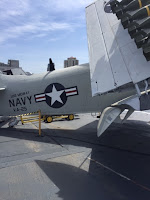

Douglas SBD-4 Dauntless BuNo 54654 (left) and North American SNJ-5 Texan BuNo 91091 (right) inside the hangar deck exhibit of the USS Midway Museum.
The hangar deck of the USS Midway Museum contains planes that were/are stored in the hangar of an aircraft carrier below the flight deck. Although the hangar deck of the Midway houses a plethora of Navy aircraft, just two of the planes in the hangar deck hailed from Southern California, the Douglas SBD Dauntless and North American Texan trainer.
The SBD Dauntless (also called A-24 in US Army Air Force service) was one of the Navy's premier American dive bombers of World War II, playing a key role in delivering a one-two punch to the Imperial Japanese Navy's carriers at the Battle of Midway in June 1942. Designed by Ed Heinemann in the late 1930s based on the earlier Northrop BT dive bomber and first flown in May 1, 1940, the Dauntless became the US Navy's linchpin in checking the wave of Japanese aggression in the Pacific, sinking all four Japanese carriers at Midway(Akagi, Hiryu, Kaga, and Soryu) and attacking Japanese shipping at the Battle of Guadalcanal in the Solomon Islands in November 1942. A total of 5,936 SBDs and A-24s were built, and some airframes were built at a Douglas plant in El Segundo, California, while the rest were built in Tulsa, Oklahoma. The SBD was nicknamed "Slow But Deadly" by pilots because of its slow speed relative to propeller-driven fighters but lethality in dealing with the Imperial Japanese Navy.
The North American Texan trainer I photographed in the hangar deck was built for the United States Navy and designated SNJ-5 (SN=Scout Trainer; J=North American Aviation). The Texan was the most mass-produced American monoplane trainer aircraft of World War II, with over 15,000 aircraft built for the US armed forces, the Commonwealth, and many other countries. In US Army Air Corps/US Army Air Force/US Air Force service the Texan was known by several designations, including BC-1, BC-2, AT-6, AT-16, and T-6, while the US Navy referred to the Texan as the SNJ and later TJ. The Royal Air Force and Royal Navy, on the other hand, allocated the name Harvard to the Texan in accordance with the tendency to name trainer aircraft after universities and other places of tuition.
   |
| Douglas attack aircraft on USS Midway deck, from left to right: Douglas AD-4W Skyraider (BuNo 127922); Douglas EKA-3B Skywarrior (BuNo 142251); Douglas A-4F Skyhawk (BuNo 154977). |
Going up to the flight deck of the USS Midway Museum, one of the most formidable sights on display on the deck was a trio of attack aircraft designed at the El Segundo Division of Douglas Aircraft by Ed Heinemann (1908-1991). Capitalizing on the success of his SBD Dauntless dive bomber, Heinemann worked on advanced piston-engine attack aircraft for the US Navy in the last years of World War II, including the SB2D/BTD Destroyer, TB2D Skypirate torpedo-bomber, and eventually the BTD/AD Skyraider (designated A-1 under a 1962 Tri-service aircraft designation system), but only the Skyraider entered mass production. Despite arriving too late for World War II (its first flight was on March 18, 1945, about 6 months before V-J day), the Skyraider would go on to see action in Korea and Vietnam, with over 3,100 aircraft built, serving with Navy, Air Force, and Marines in ground attack and counter-insurgency (COIN) functions. During the Vietnam War, the Americans and South Vietnamese used Skyraiders to launch rocket attacks against Vietcong positions in South Vietnam. The A3D/A-3 Skywarrior, on the other hand, was designed by Heinemann himself in response to a US Navy requirement for a nuclear-armed strategic bomber that could operate from large carriers. Nicknamed the "Whale" by Navy crews due to its large size, the Skywarrior became the mainstay of the Navy's strategic nuclear strike force in the 1950s, but as the Cold War progressed, it became adapted for use as a tanker, electronic warfare platform, and photo-reconnaissance plane, especially during the Vietnam War. The A-4 Skyhawk on the Midway deck, however, was the most prolific Cold War aircraft design conceived by Ed Heinemann. Nicknamed the "Hot Rod", it was originally designated A4D and became popular with Navy pilots accustomed to close air support, with 2,960 built. The Skyhawk served in the Vietnam War, Yom Kippur War, and Falklands War, and A-4s were exported to Argentina, Australia, Brazil, Indonesia, Israel, Kuwait, Malaysia, New Zealand, and Singapore; Argentina used its A-4s against British vessels in the Falklands. Although the A-4 no longer serves its country of origin, a small number of Skyhawks still fly with Argentina.
   |
| North American T-2 Buckeye jet trainer (BuNo 156697) (left); North American RA-5C Vigilante reconnaissance jet (BuNo 156641) (middle); Lockheed S-3 Viking ASW aircraft (BuNo 159766) (right) |



